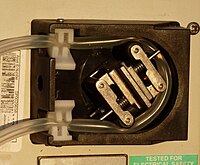
Photo from wikipedia
Conventional magnet manufacturing is a significant bottleneck in the development processes of products that use magnets, because every design adaption requires production steps with long lead times. Additive manufacturing of… Click to show full abstract
Conventional magnet manufacturing is a significant bottleneck in the development processes of products that use magnets, because every design adaption requires production steps with long lead times. Additive manufacturing of magnetic components delivers the opportunity to shift to agile and test-driven development in early prototyping stages, as well as new possibilities for complex designs. In an effort to simplify integration of magnetic components, the current work presents a method to directly print polymer-bonded hard magnets of arbitrary shape into thermoplastic parts by fused deposition modeling. This method was applied to an early prototype design of a rotary blood pump with magnetic bearing and magnetic drive coupling. Thermoplastics were compounded with 56 vol.% isotropic NdFeB powder to manufacture printable filament. With a powder loading of 56 vol.%, remanences of 350 mT and adequate mechanical flexibility for robust processability were achieved. This compound allowed us to print a prototype of a turbodynamic pump with integrated magnets in the impeller and housing in one piece on a low-cost, end-user 3D printer. Then, the magnetic components in the printed pump were fully magnetized in a pulsed Bitter coil. The pump impeller is driven by magnetic coupling to non-printed permanent magnets rotated by a brushless DC motor, resulting in a flow rate of 3 L/min at 1000 rpm. For the first time, an application of combined multi-material and magnet printing by fused deposition modeling was shown. The presented process significantly simplifies the prototyping of products that use magnets, such as rotary blood pumps, and opens the door for more complex and innovative designs. It will also help postpone the shift to conventional manufacturing methods to later phases of the development process.
Journal Title: Applied Sciences
Year Published: 2018
Link to full text (if available)
Share on Social Media: Sign Up to like & get
recommendations!